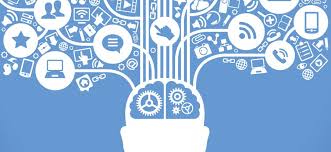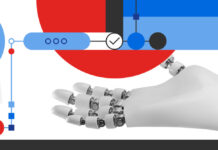New technologies are radically shaping how psychiatry is being practiced. From pills with tracking devices to algorithms meant to detect ‘mental disorders’ in voice recordings, these new tools are also changing how service-users are making sense of their experiences.
In a new article for the publication Somatosphere, medical anthropologists Dörte Bemme, Natassia Brenman, and Beth Semel explore how attempts to identify mental pathology via our online behavior data, known as “digital phenotyping,” can shift the philosophical foundations of psychiatry. They also point out how the pharmaceutical industry can game these changes:
“Increasingly, digital subjects are characterized by what might become of a person: what might be experienced as normal may be marked by underlying, ‘silent’ signs of future pathology. . . Whilst the emerging picture of digital psy can’t be captured by a simple medicalization narrative, it is worth tracking the making and the makers of this potentially-ill digital subject, in part by tracking its emergent value in scientific and pharmaceutical circles. A particular aggregation of ‘early’ digital biomarkers may carry a very different kind of potentiality – one bound up with the speculative work and commercial stakes of drug development.”
 Digital mental health interventions come in many forms. Yet, the variety of data-hungry apps and trackers available may be obfuscating the broad-scale changes to the whole enterprise of the emerging field of digital psychiatry. Ethnographic research sheds light on the new regime of “digital phenotyping,” how it greatly expands psychiatry’s reach and purpose and founds itself upon a paradoxical, distanced intimacy typical of digital technologies.
Digital mental health interventions come in many forms. Yet, the variety of data-hungry apps and trackers available may be obfuscating the broad-scale changes to the whole enterprise of the emerging field of digital psychiatry. Ethnographic research sheds light on the new regime of “digital phenotyping,” how it greatly expands psychiatry’s reach and purpose and founds itself upon a paradoxical, distanced intimacy typical of digital technologies.
In the vast landscape of digital mental health, meditation apps, psychiatrist-designed video resources, and all forms of ‘track-and-share’ technologies intervene at different stages of mental health issues. Some promote wellness, happiness, and productivity and are fully operated by users seeking to improve their mental health independent of professional practitioners. Others land more squarely in the existing psychiatric landscape, monitoring patients in between doctor visits or complementing attendants’ work in in-patient facilities. This includes even prescribed medications with trackers inside of them to ensure patients do not stealthily refuse pills.
These interventions and others share digital psychiatry’s motivating goals: extending the scale of psychiatric care outward, across the globe, and further inward, expanding the range of biomarkers and symptoms that may become meaningful to psychiatrists. Tracking and collecting patient data beyond the confines of the clinic or lab enables new practices of screening, diagnosis, and treatment. Those committed to digital phenotyping search across all trackable human behavior for bio-medically relevant signs, using the new language of data to redraw the boundaries of mental illness and healthiness.
In their ethnographic exploration of the subject of digital psychiatry, an interdisciplinary team of U.S. and U.K.-based researchers distill the common features of “digital psy” the meaning of its new methodologies, and the socio-technical relations that draw together disparate subjects from whom an immense quantity of behavioral data is now passively collected.
Engagement with empirical studies and software design in clinical laboratories led the researchers to appreciate the complexity of producing meaning and new forms of therapeutic efficacy from digital datasets. They note that where the central units of analysis in the mental health fields have always been the individual or the population, digital psychiatry productively scrambles these via newly observed digital phenotyping knowledge practices. Experimentation in making meaning from digital traces challenges definitions of the individual and their constituent ‘parts.’
“Digital phenotyping denotes recent efforts to harness digital traces of human behavior as signs, symptoms, and risk factors of mental disorders. A person’s voice tonality, mobility pattern, or typing speed on their smartphones, once made legible through computational analysis, is hoped to predict the onset or relapse of depression, manic behavior, cognitive decline, or suicidality.”
At once construed as the target of interventions and active participants in the production of data, the lines between those who produce knowledge and those produced by it are scrambled. Subjects of digital psy are constructed as “objective subjects” brought into being by access to data traces. Some of these are actively produced by users of collection technologies (e.g., text input), and others are collected passively from them (e.g., footsteps, gait, and geolocation). These are often aggregated into larger datasets to spot patterns and trends that signify risk or illness. Such markers may not map on one for one with practitioners or patient’s understanding of symptoms.
Because digital phenotyping echoes the search for non-linguistic, “hard” biomarkers of mental pathology, its research methods contribute to a vision of psychiatry in which shared linguistic constructs, symptom recall, interpersonal rapport, and the defined location of the clinic may become obsolete. Ironically, data derived from the particular and the contextual are used to eliminate these factors in the name of universality.
This is a matter of scale in digital data practices, important because a key promise of digital phenotyping is providing access to geographically remote or otherwise hard to reach subjects. As a knowledge practice, it involves moving between big data sets, individual subjects, and the tiny traces that constitute the subject and set simultaneously.
“Forged in algorithmic labor and the aggregate, subjects, and matters of concern now emerge from flexibly arranged data points – assembling moods, sounds, step counts, typing speeds, activity levels, gait quality, or the distance between a mother and child – into new epistemic objects.”
Yet, for all this, coming to know mental health and illness via digital data is no magic trick; it requires design, maintenance of technical infrastructure, and “new care practices and forms of relationality revolving around the interpretation of digital data.” Behind the veil of robots, graphs, and statistics lies the never-neutral work of selecting salient markers, listening, and interpreting, which technologies are supposed to learn from and mimic. In this model, successful software could export situated clinical judgments all over the world.
Nevertheless, the software may not always have the same authoritative presence as an in-person clinician, making space for the intended recipients of digital interventions and the research subjects who populate datasets to subvert and re-appropriate these technological practices.
Data points making up the new “aggregate human” are so bountiful that we may know too much to use standard diagnostic categories and labels. While this could be freeing to those stigmatized by such labels, what happens to the communities of survivors that relate through these shared premises? The researchers suggest that we remain open, curious, and critical about how digital psychiatry defines its objects of study and redefines the search for signs and symptoms.
****
Bemme, D., Brenman, N., Semel, B. (2020). The subjects of digital psychiatry. Somatosphere. Retrieved from: http://somatosphere.net/2020/subjects-of-digital-psychiatry.html/















Yeah. Sounds like ‘Surveillance’ rather than ‘Digital’ psychiatry.
This is ridiculous because human problems assigned mental disorders are deeply personal, symbolic, and contextual. And a machine can’t read that.
Monitoring humanity expression’s ‘FORMS’, rather than ‘MEANING’ cannot solve problems. At best it can police and enforce a system (psychiatry my old friend here you are…).
On a side note, this completely inadequate device also shows that the psychiatrists behind it don’t understand shit about what their work is about, and are thus also utterly inadequate.
They should be fired and mocked.
Seriously, humanity’s proficency in self-servingness, megalomany, and blind dumbness is AMAZING.
Report comment
Medicine gave us 30 more years to be able to be more ridiculous.
Report comment
Glad I’m not the only one who thought this sounded psycho; not to mention (“we may know too much …”) delusions of grandeur filled.
It sounds like psychiatry, grasping at straws, to find some other excuse to blame getting rid of their already debunked DSM, other than psychiatry’s complete and utter corruption, scientific fraud and failure.
Report comment
Pretty much. It’s control creeping under the guise of help. Also, don’t underestimate the capability of algorithms (and the people/groups behind them) to discern things. That would be dangerous.
And a pill with a tracker in it? : https://www.fda.gov/news-events/press-announcements/fda-approves-pill-sensor-digitally-tracks-if-patients-have-ingested-their-medication
The article includes gems like:
” Being able to track ingestion of medications prescribed for mental illness may be useful for some patients,” said Mitchell Mathis, M.D., director of the Division of Psychiatry Products in the FDA’s Center for Drug Evaluation and Research. “The FDA supports the development and use of new technology in prescription drugs and is committed to working with companies to understand how technology might benefit patients and prescribers.”
Useful to whom? To the person you have labelled? To the man who has labelled him? To the family members?
“Schizophrenia is a chronic, severe and disabling brain disorder. About 1 percent of Americans have this illness. Typically, symptoms are first seen in adults younger than 30 years of age. Symptoms of those with schizophrenia include hearing voices, believing other people are reading their minds or controlling their thoughts, and being suspicious or withdrawn. Bipolar disorder, also known as manic-depressive illness, is another brain disorder that causes unusual shifts in mood, energy, activity levels and the ability to carry out day-to-day tasks. The symptoms of bipolar disorder include alternating periods of depression and high or irritable mood, increased activity and restlessness, racing thoughts, talking fast, impulsive behavior and a decreased need for sleep.”
Notice how there’s no mention of psychiatric drugs themselves causing mania and psychosis and subsequent diagnoses of “bipolar disorder” in people.
Also you have to wonder what the words “brain disorder” associated with those psychiatric terms would tend to imply in the minds of people.
Ridiculous! How is this even allowed to happen?
Who knows what kind of data is collected off of MadInAmerica posts and articles (and other similar sites and groups)? Every post and article put out there is just more data for someone else.
Report comment
Each day the number of “normals” is going down LOL. The only normals soon standing
will be psych.
Report comment
I liken the concept of Digital Psychiatry to proctology – it gives them the opportunity to stick a finger up their behind.
Report comment
OHH gOoDdy……I ”’WoNdEr IF thiss Typing IS HelpFLU
in Idenntirifying A plathogoly.
Report comment
Do psychiatrists ever examine themselves for pathology? There’s plenty to be found.
Report comment
Absolutely horrifying!!! If anything like this is ever rolled out, my computer will be redundant for everything other than online shopping, bill paying, and banking. I do not wish to be surveilled, diagnosed and drugged by some algorithm designed by money hungry shrinks and their even more money hungry drug companies!
How much more stupidly inhuman can humans possibly become?
Report comment
How can there be “digital markers” of “mental disorders” when there are no actual BIOLOGICAL markers to distinguish whether or not someone has a “disorder” or not?
This is rank idiocy!
Report comment
“I just feel more and more alienated..the more I hear about the internet and everything, it sounds very sinister.”–Edward Gorey
Report comment
What is scary is that most of the public is fine with experimentation,
even upon itself.
Report comment